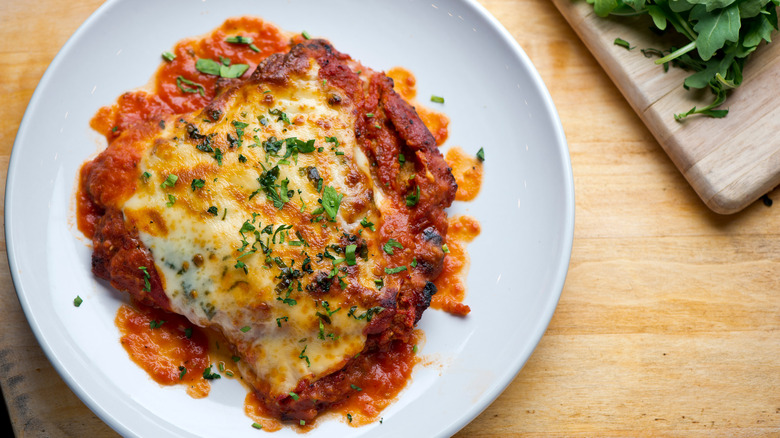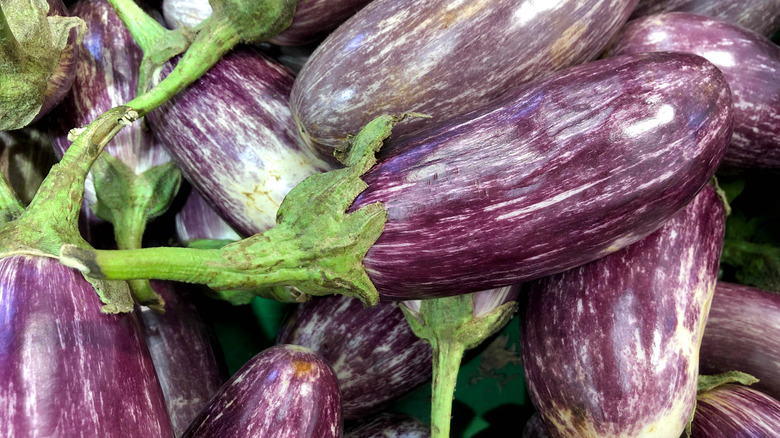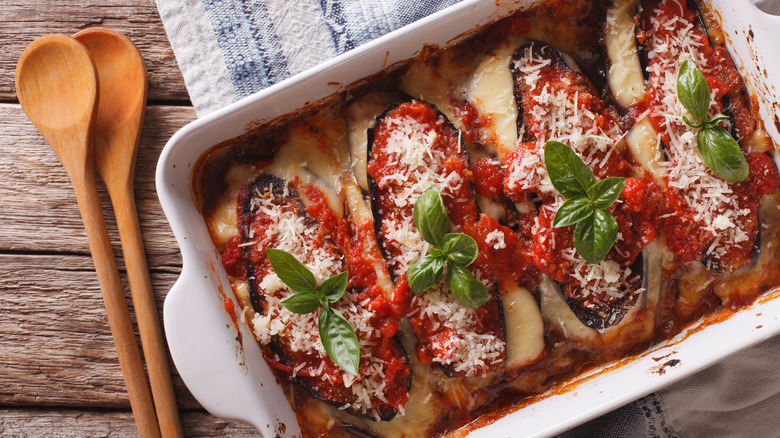The Origins Of Chicken Parmesan Have Nothing To Do With Chicken
If you go to an Italian restaurant in the United States, you're bound to find some dishes that have more ties to America than to the Old Country. A classic example is spaghetti and meatballs, which, though strongly associated with Italian culture, is a relatively recent pairing plated far beyond the Bel Paese.
According to Smithsonian, the dish likely came about when millions of Italians immigrated to the U.S. between the turn of the century and the roaring 1920s, hoping to escape the poverty that had swept their homeland. The quality beef that had once been considered a luxury was now more affordable than ever, which inspired Italian immigrants to add larger quantities of it to meatballs and add them to pasta.
Another example is chicken parmesan: butterflied chicken cutlets baked under a bed of marinara sauce ("red sauce," if you please), seasoned bread crumbs, and bubbly mozzarella cheese. While a similar dish was invented in Italy, its poultry-based counterpart was not.
Eggplant inception
Just like the beef that was inaccessible to Italians before the diaspora, chicken was also thin on the ground in the Old Country. So, just like spaghetti and meatballs, chicken parmesan didn't appear on Italian American menus until the 20th century. It was inspired, however, by a dish that was already beloved in Italy: melanzane alla Parmigiana. It's essentially the same dish, but with eggplant instead of chicken.
Paesana explains that the dish first became popular in southern regions such as Campania and Sicily around the 18th century. Its name possibly derives from the Sicilian word palmigiana, or "horizontal slats on a roof." The chicken version didn't enter popular rotation until the 1940s or '50s. And while no one knows who invented it, it's widely accepted that it came to be in the restaurants of Italian immigrants on the east coast.
Broadsheet traces one of the first chicken parm recipes to 1944 Maryland, where it was (and still is) served over a bed of spaghetti.
The earliest version of the dish wasn't made with eggplant
Even before the ancient inception of the melanzane alla Parmigiana, another nightshade was used in place of eggplant.
La Cucina Italiana explains that the first record of the word parmigiana appears in "Il Cuoco Galante," a 1733 tome by Vincenzo Corrado, who worked in the kitchens of aristocratic households in 18th-century Naples. Instead of aubergine, Corrado fried zucchini in lard and seasoned it with parmesan cheese and butter before letting it burnish to perfection in the oven.
A century or later, in 1839, eggplant took zucchini's place in a seminal Napoli recipe by Ippolito Cavalcanti, featured in the cookbook "Cusina Casarinola." Per his recipe, the process for any Parmigiana is pretty similar. It says to "fry the eggplants and then arrange them in a baking pan layer by layer with the cheese, basil and stew broth or with tomato sauce and you will let them stew."


